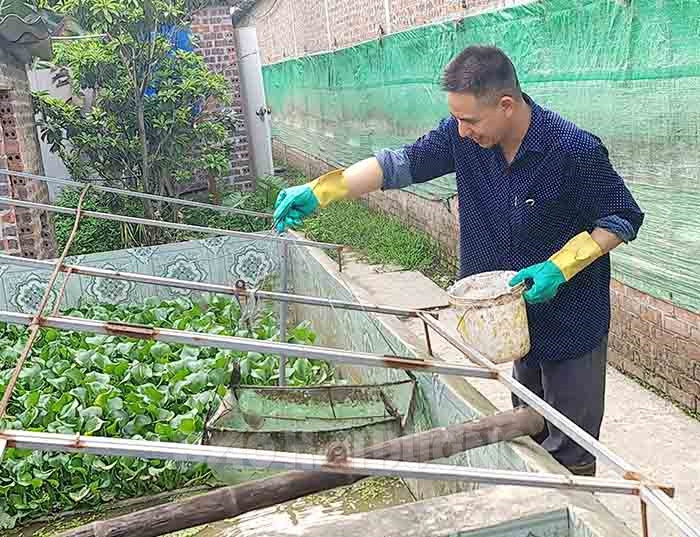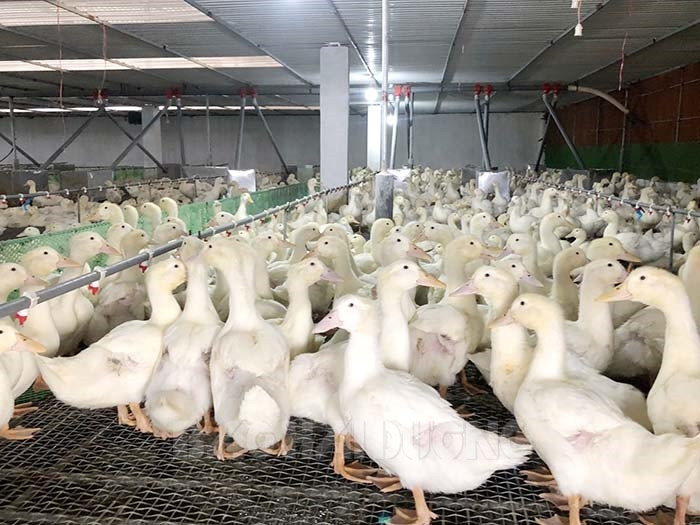To limit the impact of livestock farming activities, more and more farms in Hai Duong are applying new technology to treat waste and reduce pollution.

Mr. Nguyen Van Cam's family in Nghia Xa village, Dai Son commune (Tu Ky) raises worms under rabbit cages to help minimize livestock waste affecting the environment; worms are also a food source for soft-shell turtles, saving costs and increasing economic efficiency.
Waste treatment
Mr. Dao Van Vien's farm of more than 20 hectares in Dong Xuyen commune (Ninh Giang) is located next to the Cuu An river. This is the farm with the largest "river in pond" fish farming model in the province with a consumption output of up to 500 tons/year. The 2 duck farms here are thousands of square meters wide, each batch raising about 50,000 ducks. Despite such a large scale of farming, the farm does not emit any emissions into the environment. The fish manure suction system and pond bottom waste are thoroughly collected. All waste in the farm is in a closed, circulating loop. 17 composite biogas tanks are where waste is treated to make fuel for duck brooding and fuel for daily life.
Mr. Dao Van Vien shared: “The roof system of the farms is utilized to install solar power. This is the power source that operates the entire farm. Below is a closed, circulating waste treatment system so there is no odor, it is safe and contributes to making the environment clean, thereby there are no epidemics, and the animals on the farm develop stably”.
Instead of turning waste into fuel, the rabbit farm of Mr. Nguyen Van Cam in Nghia Xa village, Dai Son commune (Tu Ky) uses all the rabbit waste as food for worms and collects it to sell to households growing fruit trees, thus minimizing the odor coming out of the cage area. Each row of rabbit cages is placed nearly 1 meter above the ground, below are worm tanks 1.2 - 1.5 meters wide, about 16 - 17 cm high and surrounded by walls. The distance between the rows of rabbit cages is 90 cm wide and is built to make a convenient walkway for the rabbits to eat and drink.
Thanks to this combined farming method, Mr. Cam has effectively solved the problem of environmental pollution around the rabbit farming area and has an additional source of income. Previously, the farm used a dry manure press but still had wastewater flowing into the environment, so the treatment efficiency was not high. Since raising worms under the rabbit cage, it has helped save a lot of work on cleaning the cage, minimizing the source of livestock waste affecting the environment. "Worms are collected daily to feed soft-shell turtles, helping my family save about 70% of the cost. Worm manure is used to fertilize green vegetables, fruit trees, and elephant grass to feed the rabbits or sold to households in need," said Mr. Cam.
Double benefit

All duck farming waste is collected and composted in biogas tanks to be used as reusable fuel.
Waste treatment by biogas tank or earthworm farming is being applied by many livestock farms in the province, especially the earthworm farming model because it brings high economic efficiency. Mr. Nguyen Duy Cong's farm in Kinh Duong village, Thai Duong commune (Binh Giang) is one of the large-scale cattle farms. To limit environmental pollution and increase economic efficiency, he combines the cow and earthworm farming model. On an area of about 1 hectare, Mr. Cong built 2 cow barns and 9 earthworm farming areas.
According to Mr. Cong, earthworms are considered an effective manure treatment plant, helping to reduce environmental pollution. Worm manure is not only good for plants but also increases the ability to improve the soil. Earthworm manure is sold to businesses and individuals to make organic fertilizer at a price of 2,000 - 3,000 VND/kg, earthworms are sold for 50,000 - 60,000 VND/kg. After deducting expenses, each month Mr. Cong earns about 50 million VND from raising worms.
In the past, livestock farming was often one of the causes of environmental pollution. Untreated waste and wastewater discharged directly into the environment had a significant impact on the regional ecosystem. These wastes also directly affected human health, reduced animal resistance, increased disease prevention and treatment costs, reduced productivity and brought low economic efficiency... The reduced resistance of livestock and poultry increased the risk of disease outbreaks. Along with the development of the socio-economy, owners of livestock farms actively applied science and technology to treat waste such as building biogas tanks, treating waste with biological products, manure pressing and separation technology, treating waste with biological methods and covering tightly to help protect the environment.
According to statistics from the Department of Agriculture and Rural Development, the province currently has more than 500 livestock farms and 2,000 hectares of high-tech aquaculture. High-tech models in livestock and aquaculture not only help reduce production costs and labor costs, but also reduce emissions, contributing to environmental protection and increasing economic efficiency.
Mr. Nguyen Minh Duc, Deputy Head of the Provincial Department of Animal Husbandry and Veterinary Medicine, said that currently, the treatment of waste released into the environment in animal husbandry is a very important step to ensure the quality of animal husbandry as well as human health. The implementation of environmental protection solutions in animal husbandry is gradually contributing to reducing environmental pollution, promoting production development, and increasing income for people. This is the double benefit that high-tech animal husbandry models bring.
TRAN HIEN